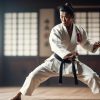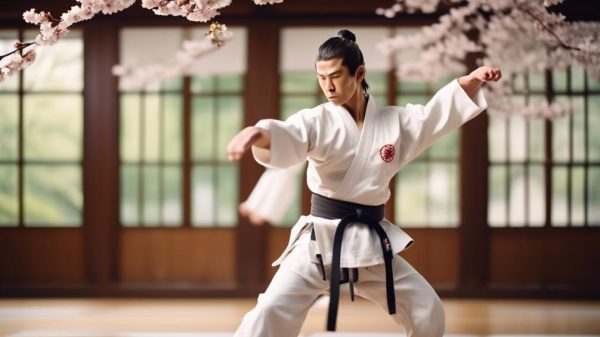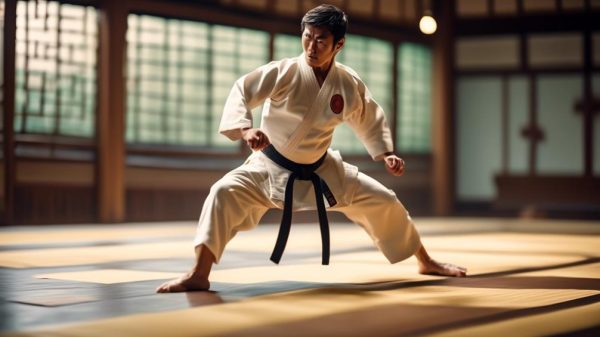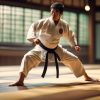The Graceful Art of Japanese Sword Drawing: An Introduction to Iaido
Iaido is a unique Japanese martial art focused on the smooth, controlled movements of drawing and sheathing the katana sword.
Unlike kendo sparring, iaido has no direct combat – instead, students perform choreographed solo kata, imagining opponents and attacks to fluidly respond to from the sheath.
This meditative practice aims to integrate mind, body and sword to generate presence, proper technique and timing in the draw of the blade.
Iaido cultivates an inner calm, coordination and ability to react intuitively under duress – with minimal movement wasted.
Students start with wooden swords, gradually working towards razor sharp live blades requiring precision and composure.
This article will outline iaido’s origins, guiding principles, training practices and traditional etiquette for those curious about the “art of mental presence and immediate reaction” in Japanese swordplay.
We’ll explain what separates iaido from partnered kendo and dispel movie myths about intense dueling sword fights. Take a look inside the peaceful world of iaido!
Understanding Iaido
Exploring the world of Iaido unveils a captivating martial art where the swift draw of the sword holds equal importance as the precision of the cut.
This discipline is deeply rooted in tradition, requiring mastery not only of the physicality of each motion but also the profound, meditative aspects.
Iaido heavily relies on katas, demanding unwavering focus and undivided attention.
Advancing in Iaido involves achieving ranks that serve as milestones, signifying progress and proficiency in a series of katas, wazas, and precise cutting techniques.
The journey to mastery is rigorous, with each rank presenting challenges that prompt delving deeper into the nuances of movement and control.
It’s not just about learning sequences; it’s about cultivating an innate sense of timing and an acute awareness of the sword’s path.
Furthermore, Iaido transcends the mere physical execution of techniques; it embodies a way of life that reveres tradition through formal class etiquette.
Demonstrating respect for the art is depicted through bowing to the teacher and the sword, acknowledging the significance of the path chosen.
Embracing Iaido katas such as So Giri and Kesa Giri refines focus, discipline, and the precision of sword movements, with each swing and cut epitomizing dedication and skill.
Historical Context
As you delve deeper into the practice of Iaido, it’s intriguing to consider its origins on the tumultuous battlefields of 15th and 16th century Japan.
Stemming from the need to defend against sudden attacks, Iaido transformed into a disciplined form of Japanese Martial Arts, prioritizing precision and a clear mind.
Understanding the historical roots of Iaido is crucial for several reasons:
- Iaido was initially developed as a survival technique, aiming to deliver a decisive blow to an opponent in one fluid motion after drawing the sword.
- This martial art places significant emphasis on ‘zanshin’, signifying a state of total situational awareness and readiness, reflecting the mental strength required of samurai.
- It incorporates intricate katas, or pre-arranged movements, which are fundamental to mastering the physical and strategic aspects of Iaido.
- Formalities such as bowing to the instructor and the sword signify respect and are integral to the philosophical foundations of the discipline.
Appreciating these historical nuances will enrich your understanding and elevate your journey towards mastery.
As you progress through the ranks, remember that every precise kata and mindful waza connect you to the rich legacy of Iaido.
Basic Techniques Explained
You will begin by learning the fundamental Iaido stance, which is essential for maintaining form and balance.
Next, you’ll perfect the technique of drawing your sword with quick and decisive movements, setting the stage for precise cuts.
Lastly, drills for cutting will refine your technique, ensuring that each strike reflects the grace and efficiency for which Iaido is renowned.
Iaido Stance Fundamentals
Mastering the fundamental stances in Iaido is essential for executing techniques with precision and grace.
As you explore the art of Iaido, you’ll realize that each movement is intentional and fluid, with the drawing of the sword at its core.
Here’s what you need to focus on:
- Posture: Maintain a poised and controlled body position.
- Footwork: Your ability to respond is dictated by stable yet agile movements.
- Grip: The efficiency of your drawing and cutting depends on how you handle your sword.
- Awareness: Stay acutely conscious of your surroundings and the position of your sword.
Dedicate yourself to these core principles, and you’ll see your practice evolve into a harmonious blend of awareness and action.
Sword Drawing Techniques
Exploring the heart of Iaido involves mastering the artful and precise techniques of sword drawing, building on a foundation of solid stances.
Achieving mastery in Iaido requires dedication to practicing katas, which are pre-arranged forms serving as a guide to responding to imaginary attacks with controlled and deliberate movements.
Each kata encompasses a series of sword drawing techniques, including the initial unsheathing (nukitsuke), the decisive cut (kiritsuke), and the ritualized re-sheathing (noto).
Engage in these katas with unwavering focus, leaving no room for hesitation or error.
Cultivate zanshin, a heightened state of awareness crucial for each technique to flow seamlessly into the next. Precision is the essence of Iaido, and it’s achieved through these techniques.
Cutting Drills Mastery
Mastering the cutting drills in Iaido requires a precise balance of accuracy, fluidity, and complete control over your blade as you delve into the foundational techniques.
Achieving mastery in cutting drills involves more than just repetitive practice; it’s about grasping the intricacy of each movement.
To truly excel in Giri (Iaido Kata), consider the following elements:
- Precision: Execute each cut with precision, ensuring it aligns perfectly with your target.
- Fluidity: Transition seamlessly between katas, avoiding any stiffness or hesitation.
- Posture: Maintain a proper stance to uphold balance and distribute power effectively.
- Focus: Your mental state should mirror the sharpness of your blade, fully engaged in every movement.
Incorporating these principles into your practice will propel you through the ranks of Iaido proficiency.
Iaido Equipment Essentials
Iaido Essentials: Gear and Equipment
In mastering Iaido, it’s essential to have the right equipment, including a range of swords from the wooden Bokken to the authentic sharp-edged Shinken, as well as the traditional keikogi and hakama attire.
Excelling in Iaido demands precision and the proper gear is crucial.
The choice of sword is pivotal in your practice. Begin with a Bokken for basic katas, then progress to an Iaito for advanced forms.
Only handle a Shinken if you’re prepared for the responsibility of a live blade, especially during Tameshigiri.
Always remember that the sword isn’t just a tool; it’s an extension of yourself.
The uniform, consisting of a keikogi and hakama, is equally important. It not only adds to the aesthetics but also facilitates movement and form.
Additionally, protective gear is vital for your safety during intense practice sessions.
Maintenance is non-negotiable. Proper care of your sword ensures your performance is never compromised.
Here’s a breakdown of the essentials:
- Sword: Bokken for beginners, Iaito for practice, Shinken for mastery
- Attire: Keikogi and hakama for proper form and movement
- Protective Gear: Men, kote, and tare for safety during practice
Elevate your Iaido journey by investing in the essentials and honoring the traditions of your discipline.
Training Exercises
Mastering Iaido’s elegant forms requires delving into training exercises that blend precision with fluid motion. Your journey in Iaido isn’t just about learning the movements; it’s about embodying the art’s core principles.
Each movement is an opportunity to refine your technique and enhance your understanding of this profound discipline.
Consider these pivotal aspects of your training regimen:
- Katas: Iaido’s soul lies within its katas, each worth 10 points in grading and crucial for demonstrating your skill and elegance.
- Cutting Techniques: Precision in your cuts reflects your level of mastery and is a testament to your discipline and dedication.
- Wazas: These forms are the building blocks of Iaido, and perfecting them is essential for your progression.
- Bowing: Often overlooked, proper bowing isn’t just a sign of respect but also a significant component of your grading.
As you train, focus on the seamless execution of your katas, ensuring each cut is delivered with intent and control.
Your wazas should flow effortlessly, one into the next, as if a natural extension of your will.
Remember, the subtleties of bowing are as critical as the strikes you deliver.
Embrace these training exercises, for they’re your path to true mastery in the art of Iaido.
Common Mistakes to Avoid
When delving into the practice of Iaido, it’s important to be aware of common mistakes that can hinder progress and reduce the quality of your training.
Perfecting your kata involves more than just executing the movements; it requires a deep understanding of the essence behind each action.
One common error to avoid is neglecting your starting posture, known as kamae. Without a strong foundation, your techniques will lack power and precision.
Avoid rushing through the movements. In Iaido, the goal isn’t speed without control; instead, the focus is on smooth and deliberate actions.
Haste can lead to sloppy form and diminish the meditative aspect of your practice.
Additionally, resist the temptation to overextend your strikes, as this can disrupt your balance and leave you vulnerable to counter-attacks in practical situations.
It’s crucial to remember that Iaido is as much a mental discipline as it’s physical. Overlooking zanshin, the state of remaining vigilant and aware after completing a technique, is a critical mistake.
It reflects a lack of readiness and composure, both of which are essential for mastery.
Lastly, it’s important to avoid training in isolation too frequently. Feedback is essential for growth.
Training within a community setting allows for shared insights and diverse perspectives, enriching your journey towards mastery.
Iaido Competitions
When you enter the competitive arena of Iaido, your kata performances come under meticulous scrutiny, serving as the battleground for earning points.
Judges will carefully analyze your every move, evaluating fluidity and precision, while your expertise in Tameshigiri could give you an edge over the competition.
It’s essential to equip yourself with a deep understanding of the rules and judging criteria to enhance your performance in Iaido tournaments.
Competition Rules Overview
[Iaido Competitions: Essential Rules]
In Iaido competitions, your performance undergoes meticulous evaluation based on the precision of each kata, the sharpness of your cuts, and the poise of your zanshin, all within a framework of strict etiquette.
As you explore the essential competition rules, it’s vital to comprehend the fundamental elements that will enhance your mastery:
- Proficiency in the primary Iaido Katas section, ensuring each movement is executed with flawless precision.
- Demonstration of exceptional cutting techniques, emphasizing the quality of each strike.
- Exhibiting zanshin, reflecting a calm and aware state of mind throughout the performance.
- Adherence to ceremonial aspects, including bowing protocols that embody respect and discipline.
Judging Criteria Explained
Understanding the judging criteria is essential for success in Iaido competitions. Judges carefully evaluate every aspect of your swordsmanship, from the precision of your katas to the poise of your zanshin.
Mastery goes beyond simply wielding a sword; it entails embodying the way of the blade with each meticulously executed kata.
Your performance must exhibit fluidity and control, with judges awarding points for precision that comes from dedicated practice.
The angles of your cuts and your ability to maintain zanshin under pressure are crucial, reflecting your mental and physical cohesion.
Even the bowing ceremonies are judged, demonstrating the discipline’s respect for tradition.
To excel, every move must be deliberate and sharp—this encapsulates the essence of the judging criteria in Iaido.
Preparing for Iaido Tournaments
To excel in Iaido tournaments, you must dedicate yourself to refining your katas and cutting techniques with unwavering precision.
Your movements should embody the fluidity and exactness that Iaido demands.
To prepare effectively:
- Fully immerse yourself in mastering the intricacies of each kata, recognizing that every motion significantly contributes to your overall score.
- Regularly practice Tameshigiri to enhance your cutting skills, ensuring that your technique is both accurate and effective.
- Cultivate zanshin, the heightened state of awareness, to demonstrate impeccable focus and control during your performance.
- Gain a deep understanding of the scoring system, knowing how points are allocated for each kata to strategize your performance effectively.
Armed with these elements, you’ll approach Iaido tournaments ready to showcase the mastery you’ve cultivated.
Advancing Your Practice
Mastering advanced katas and wazas is crucial as you strive to sharpen your technique and precision in Iaido.
To advance your practice, you must dedicate yourself to understanding the subtleties of each movement.
It’s not just about the physical execution, but also about developing zanshin, the calm and reflective state of mind that allows for true mastery.
Your progression is measured by proficiency in not only katas and wazas but also in cutting techniques.
Each level of advancement requires a deeper comprehension and a more refined performance.
Remember, successful grading is also contingent on performing the bowing ceremony correctly, which underscores your respect and discipline towards the art.
Here’s a brief overview to guide you:
| Aspect | Significance | Approach |
|---|---|---|
| Kata Mastery | Core of Iaido, each with unique significance | Analyze and practice each kata’s application |
| Zanshin Development | Mental focus and calmness | Integrate mindfulness and reflection in training |
| Cutting Techniques | Measurement of skill and precision | Consistent practice with a focus on form and accuracy |
| Bowing Ceremony | Respect and discipline | Learn and execute with precision |
Gaining proficiency and accumulating points for higher grading marks your growth. Keep pushing the boundaries, and you’ll see your Iaido practice reach new heights.
Is Iaido Better Than Kendo?
When comparing Iaido and Kendo, it’s important to note that neither is inherently superior to the other; it ultimately comes down to personal preference.
Iaido focuses on the art of drawing the sword, mental discipline, and physical benefits, which may better align with an individual’s specific goals and interests.
Does Iaido Have a Belt System?
Iaido is not about collecting belts; it’s about mastering the art. The focus is on skill over symbols, honoring the tradition of maintaining your sword rather than showcasing stripes.
As you ascend, remember that it’s the dedication to the art that marks your progress, not the attire.
How Many Katas Are There in Iaido?
In Iaido, you will learn and master 12 katas, each offering variations to improve your technique. It is crucial to practice in proper attire and remember to maintain your sword, as it is essential to keep your movements sharp and precise.
Is Iaido Spiritual?
Iaido is more than just a physical practice with a sword; it encompasses a profound spiritual journey. Its roots require mental discipline similar to that of Zen.
Through Iaido, individuals can cultivate a deep connection with themselves, mastering not only the art of the blade but also their inner selves.









